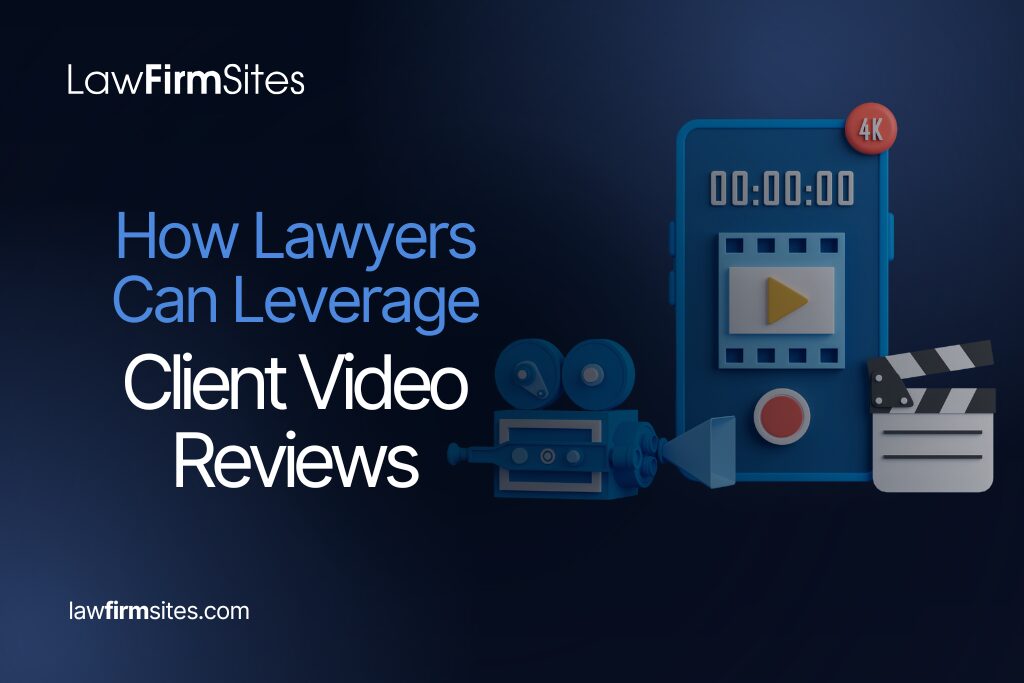How Lawyers Can Leverage Client Video Reviews?

Client video reviews are rapidly becoming one of the most persuasive trust signals in legal marketing. Using videos in marketing puts a real voice, face, and story behind a review, helping prospective clients evaluate credibility, empathy, and professionalism in a few seconds. When produced and published responsibly, these clips reinforce ethical communications and improve search visibility. This guide explains why client video testimonials matter, how they help your firm, and practical ways to request and use them while staying compliant.
How Important are Client Video Reviews for Law Firms?
For people who are anxious about hiring a lawyer, social proof carries unusual weight. Multiple studies show that reviews influence decisions across service categories, and video consistently increases understanding and trust.
In large cross‑industry surveys, most marketers report strong returns from video as a format, noting that short videos in the 30–120 second range perform best for engagement and conversions. That aligns with how legal prospects behave: they are skimming options, comparing trust signals, and looking for quick evidence that a firm communicates clearly and treats people with respect. Placing authentic video reviews near key decision pages, practice area pages, attorney bios, and intake pages helps potential clients visualize what working with your firm feels like.
Video reviews also reinforce your firm’s E‑E‑A‑T signals experience, expertise, authoritativeness, and trustworthiness by showing real outcomes and real clients speaking in their own words. Search engines and users both tend to reward content that demonstrates genuine experience. On a practical level, embedding video on high‑intent pages can increase time on page and keep visitors engaged long enough to take the next step, such as calling, starting a chat, or booking a consultation.
Ethics should frame the conversation, as even truthful statements can mislead if they create unjustified expectations about results without context. That means your video reviews must avoid promises, guarantees, or statements implying that a past result ensures future success. Simple guardrails like a short on‑screen disclaimer and careful editing to remove superlatives tied to outcomes preserve the testimonial’s value while keeping your content aligned with professional standards.
What are the Benefits of Client Video Reviews?
Client video reviews supply credibility you cannot easily replicate with written quotes alone. Seeing body language and hearing tone communicates sincerity and reduces perceived risk for first‑time callers. This credibility often translates into measurable gains: more form submissions, higher call volume, stronger conversion rates from organic search, and greater retention when prospects are comparing you against a shortlist of firms.
Enriches your local SEO footprint
When video reviews live on your website with optimized titles, transcripts, and structured data, they create additional entry points for searchers. If you host on a platform that supports captions and schema markup, you allow search engines to understand the content, index the spoken phrases, and sometimes surface rich results. Pair these videos with your Google Business Profile strategy. While Google reviews themselves are text‑based, the conversations that follow your replies, links to helpful resources, and embedded video testimonials on your site can strengthen the overall narrative about your firm across the web.
Helps with content repurposing
A single two‑minute testimonial can be edited into shorter clips for social, quoted in a case‑type explainer, transcribed into a written review, and featured in email nurture sequences. This multiplies the impact of one client story across multiple touchpoints, which is especially valuable for smaller firms seeking efficient marketing wins.
Encourages ethical transparency
When you invite clients to share their experience in their own words, you highlight client care, communication, and dignity. Even when a video discusses challenges along the way, the fact that a former client is willing to go on record can be more persuasive than polished copy.
Can you Directly Ask your Clients to Make Video Reviews?
Client reviews can be requested, but they must be done thoughtfully, ethically, and in line with platform and regulator guidance. In the United States, the Federal Trade Commission’s Endorsement Guides apply to testimonials and reviews across media. If you provide any incentive, such as a gift card, you must ensure clear, conspicuous disclosures, and you should never condition the incentive on a positive rating.
For law firms, incentivizing case‑related testimonials may also raise professional‑responsibility concerns in your jurisdiction. A safer approach is a voluntary, no‑incentive invitation to share an experience after the representation concludes. Here are some tips to keep in mind:
- Start with consent and timing
Ask only after the matter is closed and billing is complete, and confirm in writing that the client is comfortable appearing on video. Maintain a simple release form specifying where the video will appear, how long you may use it, and the right to withdraw consent. Give clients the option to use a first name only or no name at all, and never reveal sensitive facts that are not already public record.
- Make it effortless
Most compelling testimonials can be captured with a smartphone and good natural light. Share a short prep note that encourages clients to speak conversationally about three prompts: what problem led them to seek counsel, what it was like to work with the team, and how they felt about the process and resolution. Remind them not to discuss specific dollar amounts, confidential facts, or details that could be misinterpreted as a promise of results for others.
- Offer a guided alternative
Some clients prefer a brief recorded interview on a video call. A lawyer or intake professional can ask open‑ended questions that invite reflection rather than soundbites. Keep the call under fifteen minutes, ask permission before recording, and stop immediately if the client seems uncomfortable. When you edit, preserve the client’s authentic voice. Tighten pauses, remove filler words, and add captions, but avoid script‑like narration or leading overlays that could change the meaning of what was said.
- Respect platform rules
If you post a clip on social media, follow each platform’s requirements for disclosures and branded content. If you direct clients to leave a review on Google, do not gate or filter which clients you invite, and do not offer incentives tied to sentiment. Your request should be neutral and optional. In your follow‑up email, include a direct link to your Google review page, a thank‑you, and a short reminder that their experience will help others make informed decisions.
- Weave reviews into intake and follow‑up without pressure
At the end of a matter, your closing checklist can include a gentle invitation to share feedback. If the client expresses gratitude on a call or in an email, reply with appreciation and ask if they would feel comfortable sharing a short video so others can benefit from their perspective. If they decline, respect the decision and thank them anyway. Ethical review generation is about making it easy for happy clients to speak, never about persuading the reluctant.
- Think about accessibility and privacy
Always add captions for people who watch without sound or who are hard of hearing. Provide a short text summary below the video. Host the video in a way that avoids exposing personal contact details or case identifiers. If the matter involved sensitive circumstances, ask the client if they would prefer a voice‑only testimonial with anonymized visuals, such as on‑screen text and ambient footage of your office.
- Optimize for search and user experience
Publish each video on a dedicated page with a descriptive H1, a concise introduction, and a full transcript. Include schema markup and make sure to internally link from related service pages and FAQs. This creates a web of relevance that helps both users and search engines understand exactly what the video covers.
- Measure metrics and results
Consistently track how often visitors watch at least half of a testimonial, whether they scroll to your intake form afterward, and how many calls originate from pages featuring video. Use these insights to improve placement and messaging. If you notice that shorter clips perform better for certain practice areas, say, criminal defense or personal injury, prioritize concise edits for those pages while keeping longer versions on a central testimonials hub.
Practical Publishing Ideas that Work Without Hype
Place a brief video near the top of a practice area page where prospects face urgent decisions such as DUI defense, immigration filings, or probate administration. Pair it with a clear next step, such as a phone number or a simple scheduler, making sure that the call to action is calm and respectful rather than urgent or aggressive. Below are additional ideas to note:
Create a testimonials library organized by case type
A visitor researching conservatorships should be able to find stories about compassionate guidance and procedural clarity. Someone evaluating business litigation will want to hear about responsiveness, strategy, and steady communication. Grouping videos by topic keeps the experience focused and avoids the impression that you are promising outcomes across unrelated matters.
Use video reviews in email
For people who requested information but have not yet booked a consultation, a brief follow‑up email that includes a testimonial can bridge the credibility gap. Keep the text short, explain how the video might help them evaluate fit, and assure them there is no obligation. This approach respects autonomy while giving prospects a real‑world context.
Embed relevant videos on your site
When you reply publicly to a Google review with gratitude and a helpful link, such as a page containing a similar video story, you demonstrate openness and provide extra clarity for future readers. Over time, the pattern of helpful responses becomes a trust signal of its own.
Maximizing Engagement by Utilizing Video Reviews
Client video reviews, produced with care and ethics, can accelerate trust, improve engagement, and support stronger local SEO. Start with consent and plain‑spoken stories, keep production simple and accessible, and publish with a thoughtful structure so search engines and people can find what they need quickly. As you refine your approach, let performance metrics guide placement and length rather than assumptions.
If you want help planning a respectful, search‑friendly testimonial strategy, Law Firm Sites can help you map out the next steps in a way that fits your firm’s voice and values.
Did you like this post? Here are some others you might enjoy:

For most law firms, growth depends on being visible at the exact moment a potential client searches for help. Pay‑per‑click…

Strong legal marketing rewards depth. When potential clients face high-stakes decisions, they search for thorough, trustworthy guidance that clearly explains…

Data is the most reliable guide for growing a law firm website because it shows what clients actually search, where…

